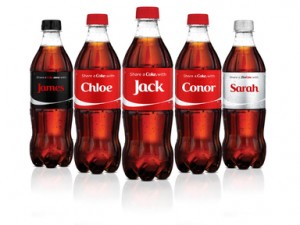You cant have failed to notice Coca Cola’s ‘Share a coke’ summer campaign which is a great modern example of marketing personalisation.
Coke replaced the iconic brand with 250 most popular british names.
To ensure that marketing personalisation is targeted it has to be customised and personalised whether personalisation is attributed to direct mail, billing, social media personalisation is the key to engaging with your audience and customers.
We are over loaded with marketing messages subliminally and consciously but how do you cut through the ever increasing noise and get your message heard?
You personalise your product or service to suit the audience that the message is intended for.
Coke’s campaign was designed to create a huge buzz and engage its audience throughout the world and it has succeeded in doing that as people take to social media platforms with images of their personalised bottle.
What is the difference between marketing personalisation and customisation?
There are two types of one to one marketing: personalisation and customisation
Personalisation occurs when the company decides what marketing mix is required for an individual this is based on previously collected data.
A perfect example of this is Amazon.com personalised recommendations that display as pop ups when you log in showing suggestions of purchases you might like to make based on your previous purchase history.
Customisation is where the customer specifies one or more elements of his or her marketing mix. An example of this is Dell Computers giving the customer the option to customise the computer they order.
Sending out unpersonalised messages doesn’t engage your audience by personalising the campaign whether it is direct mail, email marketing, social media, billing you are more likely to engage a response from your customers.
96% of organisations believe that personalised marketing improves response rates and personalised emails improve click through rates by 14% and conversion rates by 10% [Hubspot].
Irrespective of the statistics customer letters, invoices both paper and electronic, direct mail, email newsletters are being posted out unpersonalised this is a missed opportunity for further engagement with the customer.
Why is data so important?
According to the DMA [Direct Marketing Association] consumer willingness to share data with brands has increased dramatically over the past 18 months. Over 50% of the 1,193 UK adults that took part in in a survey for the DMA/fast.map data tracking report were willing to provide basic information about themselves – name, address and email to receive marketing messages.
Equifax one of the UK’s leading data providers believes that the rise in consumer confidence in sharing data is the increased transparency in privacy policies and improving practices to secure trust.
Major brands such as Unilever are ensuring their privacy policies are communicated better so that customers understand how their data is being used and 43% state that a clear easily understood data privacy policy would encourage them to share their data compared to one in three 18 months ago. Research has also proven that the better the data privacy protection policy is worded the permission to market rate can be improved by as much as 100% with the best notices reducing opt out rates by as much as 10%.
What is the point of marketing personalisation?
Engagement with customers is all about data and never has it been more important than to understand consumers habits and what drives their behaviour to buy.
Purchasing data, social media, customer service interactions and web searches are all the essential components needed to drive customers to purchase.
Ensuring that your database is kept up to date gives a valuable insight in to customers behaviour influencing how you target your specific audience and/or market.
UK Office Direct is good example of managing their customer database when orders are placed on the site it offers similar products which may be cheaper or, more expensive but the point is you are given a choice of products and associated accessories.
This form of collaborative filtering determines appropriate recommendations for
the consumer ensuring that you are made aware of all available products and accessories.
UK Office invoices which are sent electronically contain variable personalised data hi-lighting various up and coming offers, products and accessories that the consumer might be interested in the foreseeable future.
It is clever personalised and strategic marketing because each invoice they email out is highly targeted and specific to the recipient.
The more a business knows about its customer the more it can tailor the buying experience by delivering targeted and relevant content.
Like amazon, a regular visitor to a specific website starts to receive a more personalised experience because the company recommends products and services that may be of interest based on the data the customer has previously entered making the chance of click through rates significantly higher.
A more customised experience determined by consumer habits will drive conversion rates and encourage visitors to spend more. By being able to have instant access to the products they like with little effort they will respond by spending more money or by returning to the website.
The more personalised their experience is the more they are likely to share it.
Content is king
The more relevant the page the visitor lands on the more likely it will convert in to a sale. By understanding who is visiting the website, mobile site or app will ensure companies can be target specific and retarget customers with offers that make the whole buying experience relevant.
What next?
The new wave of inbound marketing is focussed on ‘personalisation’ and it is not just B2C but will focus on B2B.
By creating a more personalised experience for prospects and customers that delivers solutions to their individual problems, interests, needs and wants will positively reinforce people coming back.
How does marketing personalisation fit in with print?
Variable data printing lead the way with personalisation and the concept of personalisation is not new.
Printing variable data invoices, statements, council tax books and bills were some of the original paper based applications that were highly personalised and customised to the individual.
This form of personalisation has tripped over into the cross media marketing mix. [Cross media marketing] where marketing campaigns can include a PURL, in lay mans terms the PURL is a link that takes you to a website via a QR code or barcode that you scan with your smart phone.
Content and personalisation has always and will always be king. Good content coupled with a unique and personal buying experience will drive customers to visit your website which is ultimately what we want.







